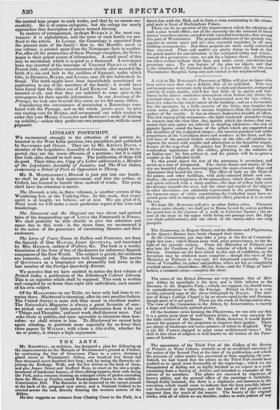The appearance of the Third Part of the Gallery of
the Society of Painters ire Water Colours, reminds us of an accidental omission of the notice of the Second Part at the time of its publication, and which the pressure of other matter has prevented us from supplying till now. Indeed, we had hoped that the plates in the Third Part would have enabled us to speak more favourably of the engravings ; which we are disappointed at finding not so highly finished as we expect in a work emanating from a Society of Artists, and intended as examples of the talents of its members. The plates are executed by engravers of known ability, and the general effect of the paintings is faithfully, though feebly imitated ; but there is a slightness and tameness in the execution, which would seem to indicate that the least possible labour was bestowed on the engraving ; and the hand of the pupil is more apparent than the touch of the master. The beauty of the original works, with all of which we are familiar, makes us more jealous of any thing short of the highest excellence in the copies. Nevertheless, with this abatement even, the present work is one of that class whose pictu- resque and varied character renders it attractive to all lovers of pictures, and, to the extent of its merits, valuable to the connoisseur. In these two Numbers, we have specimens of the best productions of COPLEY FIELDING, L/EWINT, HARDING, ROBSON, Cox, and LEWIS. Let us hope that the future numbers will be more worthy both of the painters and engravers. GASTINEAU'S beautiful picture of St. Michael's Mount, now exhibiting among the Water Colour Paintings in Pall Mall East, has been admirably lithographed by G. BARNARD, in a style that would not, we think, have been surpassed, if equalled, had it been engraved for the. work we have noticed above. The rocky mount in the distance, towering into the wild and stormy sky, and the waves dashing against the breakers in the foregfound, make up a grand and effective picture ; which has been transferred to the stone .with spirit and fidelity. The tints are pure and even, and have both depth and brightness ; and the force and feel- ing of the lithograph are scarcely inferior to those of HARDING or HAGUE.
The Studies from Nature, by this young artist, of which the Plates from VI. to X. have recently appeared, also evince a correct eye for nature and good knowledge of drawing. His studies of Trees, which are in the style of his master, HARDING, are graceful and characteristic, though somewhat heavy and monotonous, wanting the brilliancy of HARDING'S touch. They are good models for pupils ; being well de- fined, and forming a medium between loose generalization on the one
hand and a hard mechanical manlier on the other. • •
Apropos of Trees. It is a singular fact, that of the number of landscape-painters, not one out of five can draw a tree that looks like nature. Those, indeed, who succeed best, appear only to have studied trees superficially ; they do not seem to understand them botanically, or to be able to draw a bough and leaf correctly. The general cha- racter of the stem and branches, of the forms of the masses, and the distribution of the light and shade, are all that they concern them- selves about ; while the majority make a her of scribbling pass for foliage. It is bad enough for landscape-painters not to be able to draw figures, but to be at fault in trees is inexcusable. We do not of course require the form of every bough and leaf to be distinctly made oot in a drawing ; on the contrary, the slightest sketch from the hand of one who understands the object, will convey a more vivid idea of it than the most laboured fac-simile by one unacquainted with its' details.



























 Previous page
Previous page